Updated: December 16, 2025 • By Santorini Dave
My Favorite Hotels in Madrid
• 5-star: Four Seasons
• 4-star: Westin Palace
• 3-star: Room Mate Alicia
• For couples: URSO
• For families: SmartRental
• Near train station: NH Atocha
• Near Prado museum: Mercure
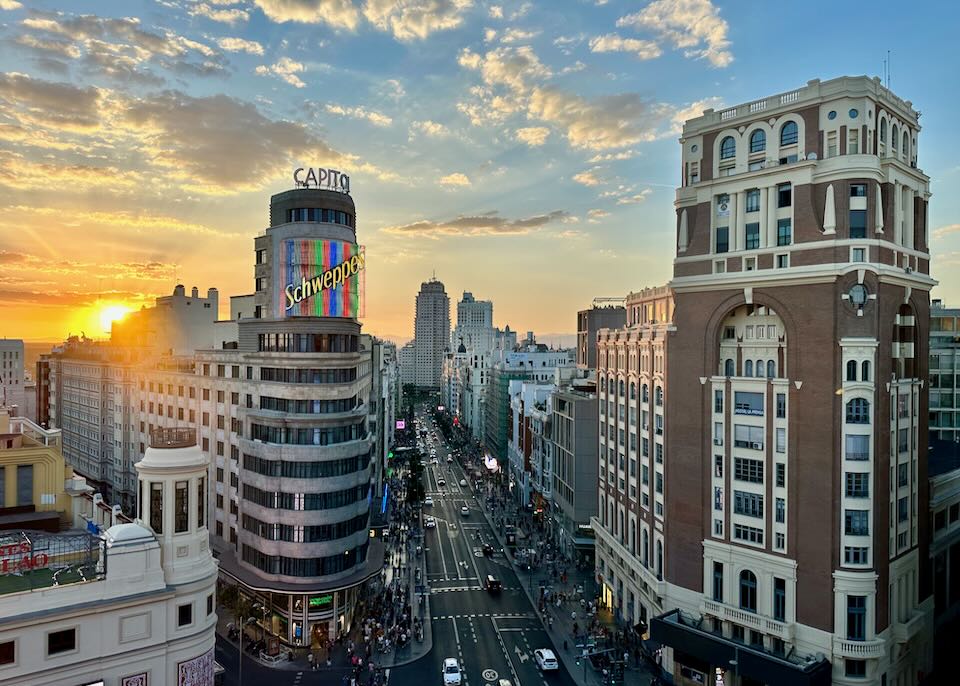
We captured this view down Madrid’s Gran Via from the excellent 4-star Riu Plaza España hotel in the Malasaña neighborhood.
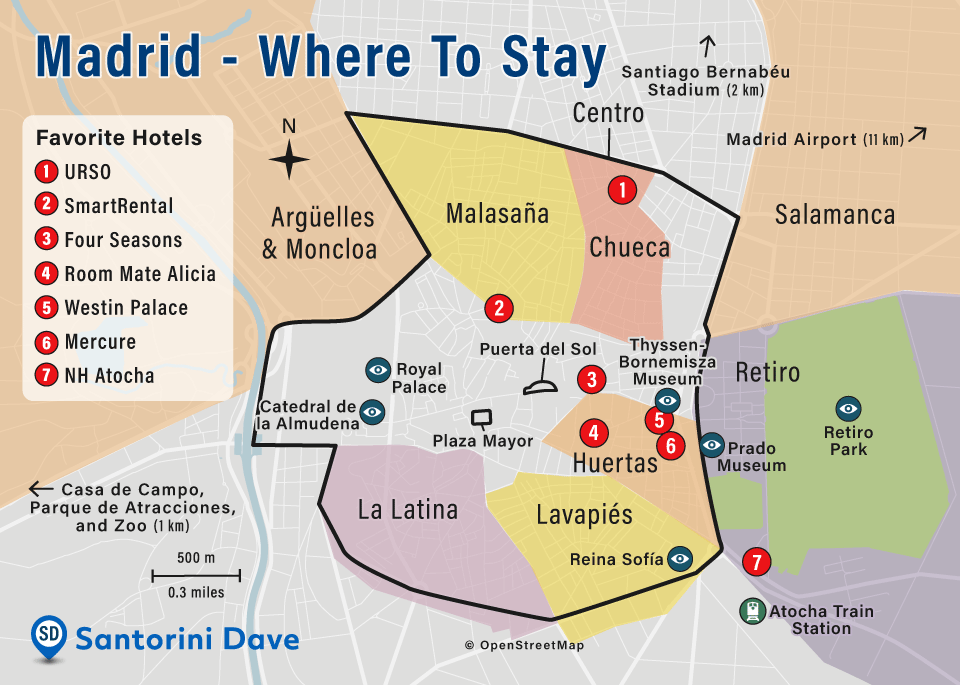
1. URSO • 2. SmartRental • 3. Four Seasons • 4. Room Mate Alicia • 5. Westin Palace • 6. Mercure • 7. NH Atocha
The Best Areas to Stay in Madrid
Madrid is the spirited, authentic heart of Spain. While it may lack the beaches of Barcelona or the Moorish monuments of Granada, it compensates with an electric energy that is unmatched in Europe. This is a city that lives in the streets. Madrid boasts the country’s most dynamic culinary scene – from century-old tapas bars to avant-garde Michelin stars – and nightlife that genuinely doesn’t stop until dawn. Culturally, it’s a heavyweight, home to the “Golden Triangle of Art” (the Prado, Reina Sofía, and Thyssen-Bornemisza museums). For travelers, Madrid offers a deep dive into the real Spain: loud, passionate, and incredibly welcoming. The city is surprisingly compact. The historic core is a dense maze of walkable neighborhoods, each with a distinct personality. You can easily walk from the grandeur of the Royal Palace to the bohemian bars of Huertas or the luxury shopping of Salamanca. The metro system is fast, safe, and air-conditioned, making it easy to hop between districts.
Madrid Neighborhoods
Madrid’s center (Centro) is the most convenient area for first-time visitors, but the surrounding barrios offer more character and often better food. There is no single “best” neighborhood; it depends entirely on whether you prioritize museums, nightlife, luxury, or local vibes.
KM 0 in the Centro neighborhood of Madrid. Located on the sidewalk in Puerta del Sol (Gate of the Sun), a public square and the center of the beginning radial network of Spanish roads.
- Centro (Sol, Gran Vía & Los Austrias): This is the geographical and historical bullseye of Madrid. It encompasses the grand Plaza Mayor, the bustling hub of Puerta del Sol, and the regal architecture of Madrid de los Austrias (Hapsburg Madrid) near the Royal Palace. To the north runs Gran Vía, the city’s frantic, Broadway-style shopping avenue. It’s the best area for first-time visitors who want to be within walking distance of absolutely everything. The vibe is touristy, crowded, and loud, but undeniably exciting. Accommodation ranges from luxury hotels on Gran Vía to budget hostels near Sol.
- La Latina: Located just south of Centro, this is the city’s oldest neighborhood and its premier tapas destination. The medieval streets are packed with taverns, particularly along the famous Cava Baja street. On Sundays, the neighborhood floods with people for El Rastro, Spain’s largest open-air flea market. Ideally suited for foodies and travelers seeking a historic, medieval atmosphere. It’s very busy on weekends and Sunday afternoons, but quieter on weekdays. Hotels here are mostly small boutique options or apartments.
- Huertas (Barrio de las Letras): The Literary Quarter, where giants like Cervantes and Hemingway once drank and wrote. Located between Sol and the Prado Museum, it’s the perfect “Goldilocks” neighborhood: charming, pedestrian-friendly, and central, but slightly less chaotic than Centro. The Plaza de Santa Ana is one of the best spots in the city for al fresco dining and people-watching. Perfect for couples and culture lovers who want a walkable base with great wine bars and jazz clubs.
The Prado Museum in Retiro
- Retiro: Named after the massive El Retiro Park, the city’s green lung. This elegant district lies east of the center and houses the “Golden Triangle of Art” (Prado, Reina Sofía, Thyssen). It’s a quieter, more residential area with wide boulevards and upscale dining. Best for art lovers, families who need space to run around, and luxury travelers. It bustles during the day with museum-goers but is very quiet at night.
- Salamanca: Madrid’s answer to the Upper East Side or Beverly Hills. Located north of Retiro park, this is the most exclusive zip code in the city. The “Golden Mile” (Calle de Serrano) is lined with designer boutiques, 5-star hotels, and Michelin-starred restaurants. Best for luxury shoppers and fine dining enthusiasts. The vibe is posh, polished, and residential. It is less “historic” looking than Centro but offers the highest standard of living.
- Chueca: The epicenter of LGBTQ+ life in Madrid and one of the most vibrant districts in Europe. Sandwiched between Salamanca and Malasaña, it’s packed with trendy boutiques, outdoor terraces, and excellent small restaurants. It’s an inclusive, fun, and high-energy area that serves as a party destination by night but a charming village by day.
- Malasaña: The birthplace of the Movida Madrileña counterculture movement in the 80s. Today, it is the hipster capital of the city, filled with vintage stores, third-wave coffee shops, tattoo parlors, and graffiti-covered bars around Plaza del Dos de Mayo. Best for younger travelers, solo travelers, and night owls. It can be noisy at night, so bring earplugs if you stay near a square.
- Lavapiés: The multicultural heart of Madrid. Just south of Huertas, it’s steep, narrow, and colorful, home to a mix of old-school Madrileños and immigrants from Africa and South Asia. It has the best Indian food in the city and a distinct, edgy artistic scene. Best for budget travelers and adventurous eaters.
- Argüelles & Moncloa: Located to the west of the center, near the massive university campus. These are student-heavy areas bordered by the beautiful Parque del Oeste and the Temple of Debod (an ancient Egyptian temple rebuilt in Madrid). Best for long-term stays and budget travelers who want a “real” residential neighborhood feel.
The Gran Via metro station in Centro.
Getting Around Madrid
Madrid is incredibly walkable; you can cross the entire city center on foot in about 30 minutes. However, the public transport system is excellent for saving time or reaching the airport.
- Metro: The subway is clean, safe, and extensive. A single ticket costs between €1.50 and €2.00 depending on distance. The best value is to buy a Multi Card (rechargeable card, €2.50) and load a “10-trip pass” (Metrobus) for €6.10. This single card can be shared by multiple people.
- Bus: Madrid’s blue EMT buses are great for sightseeing while you travel. You can pay with a contactless bank card or phone on board (€1.50) or use the 10-trip Metrobus pass mentioned above.
- Airport Express: The yellow “Exprés Aeropuerto” bus runs 24/7 between the airport (T1, T2, T4) and Atocha Station/Cibeles. It costs €5 (payable by card on board).
- Taxis & Ride Share: Official white taxis are plentiful and safe; look for a green light on the roof. Uber and Cabify are also widely available and often slightly cheaper.
- Car Rental: Do not rent a car for a stay inside Madrid. Traffic is heavy, streets are confusing, and parking is scarce and expensive. Only rent a car on the day you plan to leave the city for the countryside.
The Best Places to Stay in Madrid
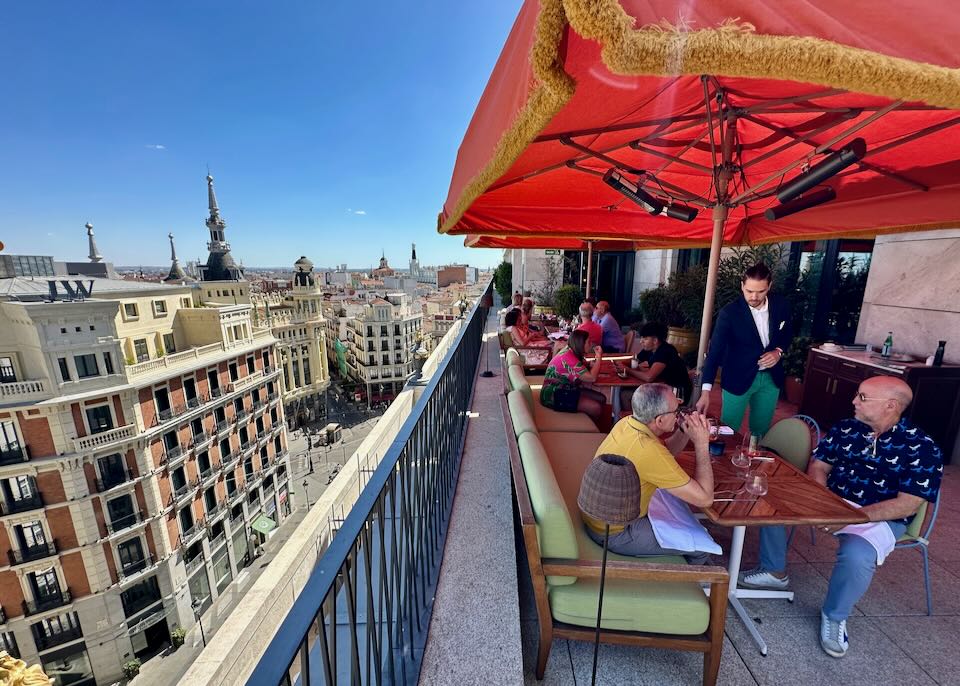
With its great central location and charming rooftop brasserie, we think the Four Seasons is the best luxury hotel in Madrid.
- Best Luxury Hotels in Madrid
Barceló Emperatriz • Four Seasons • Gran Hotel Inglés • Palacio de los Duques • Mandarin Oriental Ritz • URSO • Westin Palace- Best Boutique Hotels in Madrid
CoolRooms Palacio de Atocha • Hospes Puerta de Alcalá • Room Mate Alba • Hotel Urban- Best Cheap & Midrange Hotels in Madrid
Central Palace • Hostal Adriano • Hostal Madrid • Posada del Dragón • Room Mate Alicia- Best Hostels in Madrid
Cats Hostel Sol • The Hat • Onefam Sungate • Toc- Best Hotels for Families
SmartRental Collection Centric II • Petit Palace Lealtad PlazaOur suite at the SmartRental Collection Centric II in Madrid.
Best Neighborhoods in Madrid for…
- Best Neighborhoods in Madrid for Sightseeing: Centro, Retiro
Since most of Madrid’s main attractions are centrally located and within easy walking distance of one another, it makes sense to stay either in Centro or in Retiro, depending on whether you’re more interested in being close to the Royal Palace (Centro) or the ‘Golden Triangle’ of art museums (Retiro). But you needn’t limit yourself just to these two neighborhoods; you can easily reach the attractions of either on foot from La Latina, Chueca, and other central barrios.- Best Neighborhoods in Madrid for Nightlife: Huertas, Malasaña, Chueca
There isn’t a single best area in Madrid for nightlife; instead, several neighborhoods compete to lure in the city’s night owl clientele. Huertas is the best place to start for first-time visitors. Plaza Santa Ana and Calle Huertas offer the best choice of bars, while Kapital on Callede Atocha is one of the city’s most popular clubs. Check out “Mi madre era una groupie” for dancing, Salmón Gurú for cocktails, and Viva Madrid for a classic old-school vibe. We also like the Caracortada, Lovo, and La Santoría cocktail bars, plus the Mexican influenced Calle 365 Callejón Secreto. Head to iconic Café Central for live jazz, or Cardamomo for flamenco.Hipster Malasaña and Chueca are known for live music and LGBTQ-friendly clubs, respectively (Plaza de Chueca is the best place to start in the latter), and there are plenty of bars and clubs in both neighborhoods that stay open until sunrise. Chueca’s 1930s-themed Museo Chicote is justly popular, as is Libertad 8 and club Teatro Barceló. We also like the cocktails and popcorn at Twist & Shout Bar. In Malasaña you can’t go wrong at old school bars like La Vía Láctea, Madrid me Mata, or El Penta, spiritual home of the “Movida Madrileña” movement. For dancing, check out Café La Palma, Maravillas Club, Sala Morocco, Maderfaker, and the memorably named “El Perro de la Parte de Atrás del Coche”. The neighborhood’s historic cafés are also open late: Manuela and Café Ajenjo are both classics.
Elsewhere in the city center, La Latina is known for its tapas bars (especially on Calle de Cava Baja), studenty night clubs and flamenco “tablao” venues like Corral de la Morería, while Lavapíes features a multicultural scene and a small LGBTQ presence (especially “bares de ambiente”, aka lesbian-friendly bars).
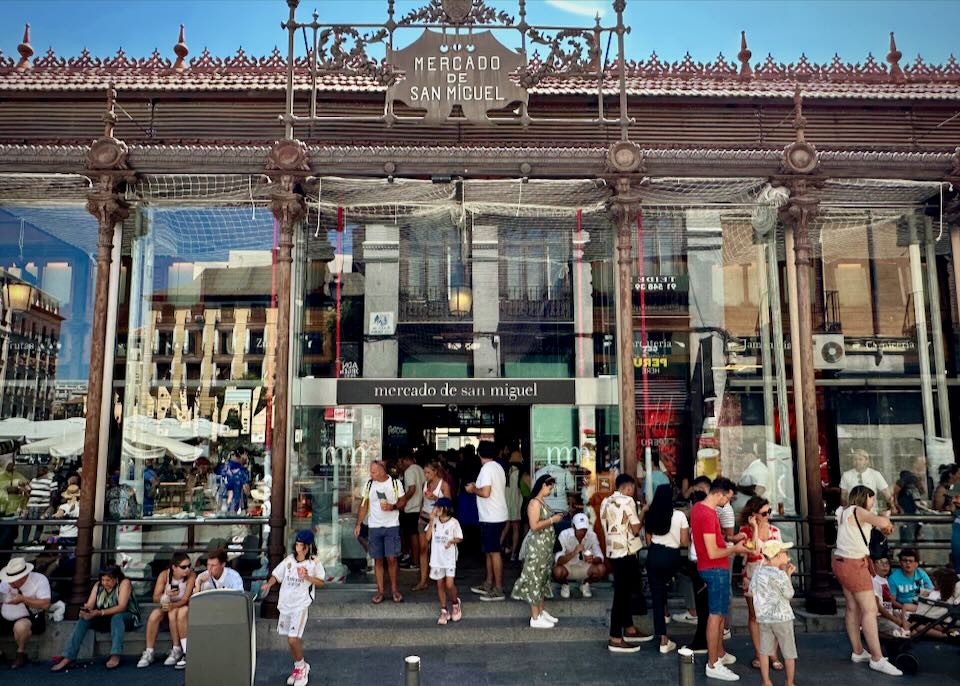
The Mercado de San Miguel in Centro
- Best Neighborhoods in Madrid for Food and Restaurants: Huertas and Chueca
There’s excellent dining to be had all over the city. To generalize, you’ll find Michelin-starred restaurants and other fine dining establishments in Salamanca and points north (notably Restaurante DiverXO), fusion restaurants in Centro and Malasaña, great Indian and Bangladeshi food along Lavapiés’ ‘Curry Mile’, and traditional tapas bars dotted all over the city center – with particular concentration in La Latina and Huertas. We like and Chueca and Huertas best. In Chueca alone there’s Comparte Bistró for Andalusian-influenced dining, El Cisne Azul for seasonal menus, Kuoco 360 for fabulous fusion, Casa Salvador with its bullfighting memorabilia, and high-end Angelita Madrid. On the edge of Centro and Huertas, Lhardy has been around since 1839 and is best known for Madrileñian stew. Elsewhere in Huertas, Chuka Ramen Bar serves the best noodles in the city, Gofio specializes in the cuisine of the Canary Islands, and La Sanabresa is a cult, no-frills Spanish favorite. La Venencia is the most atmospheric spot for tapas.- Most Romantic Neighborhood in Madrid: Centro
While Salamanca has its share of intimate restaurants, and Retiro has the beautiful park and the botanical gardens, when it comes to romancing your beloved, it’s hard to top the nostalgic charm of Centro’s cobbled streets and tiny medieval plazas.Plaza Mayor in Centro
- Best Neighborhoods in Madrid for Families: Centro, Retiro, Argüelles
Centro is good for families because its streets are very walkable and there are numerous spectacles to entertain the kids, like the captivating street performers in Puerta del Sol and Plaza Mayor. Families like Retiro because of its proximity to the park’s playgrounds, lakes (with rowing boats and pedalos), and abundance of space to run around. Argüelles is less popular with visitors, but it does have the advantage of being a quiet residential area next to a huge park, with an Egyptian temple for kids to explore.- Best Neighborhoods in Madrid for Shopping: Centro, Salamanca
The Gran Vía and the streets between it and the Puerta del Sol remain Madrid’s premier shopping zones, for locals as much as visitors, with department stores such as El Corte Inglés and chains such as Zara. For designer fashion, Salamanca is the place to go, especially Calle de Serrano. You’ll find more alternative designers and indie shops scattered throughout Malasaña and Chueca. Don’t forget also the city’s biggest market, El Rastro, the vast flea market held on Sundays in La Latina.- Best Neighborhoods in Madrid to Stay for First Timers: Centro, Retiro
If it’s your first time in Madrid, odds are you’re here to check out its main attractions. Centro is ideal for visiting the Royal Palace and for exploring the medieval streets around Plaza Mayor, while Retiro is perfect for visiting the three world-class art museums and Madrid’s most impressive park. Centro and Retiro are a 20-minute walk (or short metro ride) apart, so it’s easy to stay in either neighborhood and catch all the main sights. That said, there is some advantage to staying in Centro over Retiro: its proximity to Madrid’s nightlife, both north and south of the center, and a wealth of accommodation to suit any budget.
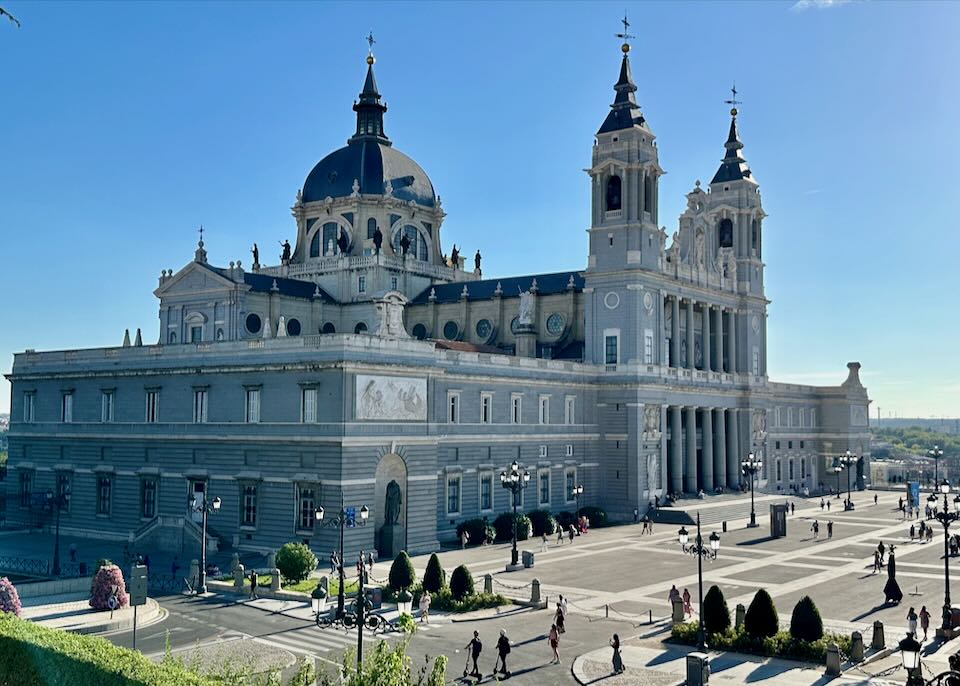
The Royal Palace
- Best Neighborhood in Madrid for a Local Vibe: Malasaña
It’s hard to get more ‘local’ in Madrid than Malasaña. While it is certainly more gentrified now than it was 10 to 20 years ago, a grungy, arty vibe remains here from the 1980s, when Malasaña was synonymous with sex, drugs, and rock music. And though independent boutiques and small art galleries have replaced many of the seedier bars, you’ll still find tattoo parlors and plenty of graffiti left over from Malasaña’s rockin’ heyday.- Best Neighborhood in Madrid without a Car: Centro
Much of Madrid’s most beautiful architecture is in Centro, and its tiny, charming medieval streets are an absolute joy to wander. That said, Madrid’s city center in its entirety, from La Latina to Retiro, is great to explore on foot.- Safest and Unsafe Areas of Madrid
Madrid’s safest neighborhoods are its more upmarket ones, such as Salamanca and Retiro. Centro, La Latina, Lavapiés, Huertas, Malasaña, Chueca, Argüelles, and Moncloa are generally safe to walk around any time of day, though normal precautions apply. In La Latina, Lavapiés, Huertas, Malasaña, and Chueca, things get very lively on weekends.Parts of Malasaña, Centro, La Latina, Lavapiés, and Huertas can be a bit sketchy at night; it’s best to stick to popular and well-lit streets with plenty of foot traffic and avoid poorly lit, deserted ones. Opportunistic pickpockets operate at the El Rastro flea market in La Latina and across the city center.
The 9 Best Neighborhoods in Madrid for Tourists
1. Centro
Puerta del Sol square is Madrid’s city center and Km Zero – the central point of the Iberian Peninsula. Always busy with foot traffic, Sol is an important transport hub and a crossroads where people meet up before heading to the numerous shops, restaurants, and bars in the surrounding streets. Just south of Sol is Plaza Mayor, Madrid’s main historic square and the focal point of medieval Madrid. There are numerous small squares, markets, and tiny streets to explore in this neighborhood. Standouts include the posh San Miguel Market, the Moorish-style Torre de Los Lujanes, and ornate Casa de Cisneros in Plaza de la Villa, the opulent Basílica de San Miguel, a grand 17th-century baroque church, and historic taverns such as Botín, which has a claim to be the oldest restaurant in the world. Don’t miss also the art filled Monasterio de las Descalzas Reales, one of Madrid’s lesser visited gems.
Mesón de la Tortilla tapas restaurant is one of many eateries along a charming street in Centro between Plaza Mayor and the San Miguel Market.
To the west, Centro is bordered by the mid-18th century Royal Palace (last used by Alfonso XIII in 1931), Teatro Real (opera house) and the massive Neoclassical Cathedral of the Armed Forces (all part of so-called Austrias or “Habsburg Madrid”), while its northern limit is Gran Vía, Madrid’s main shopping street lined with high fashion boutiques. Centro is a very walkable neighborhood that stays up late: many restaurants and bars are located in the streets close to the Plazas Mayor and Sol.
Centro boasts a vast range of accommodation, from luxury to excellent budget hotels and some of the best hostels in the city. It’s the best place to stay over all for first-timers.
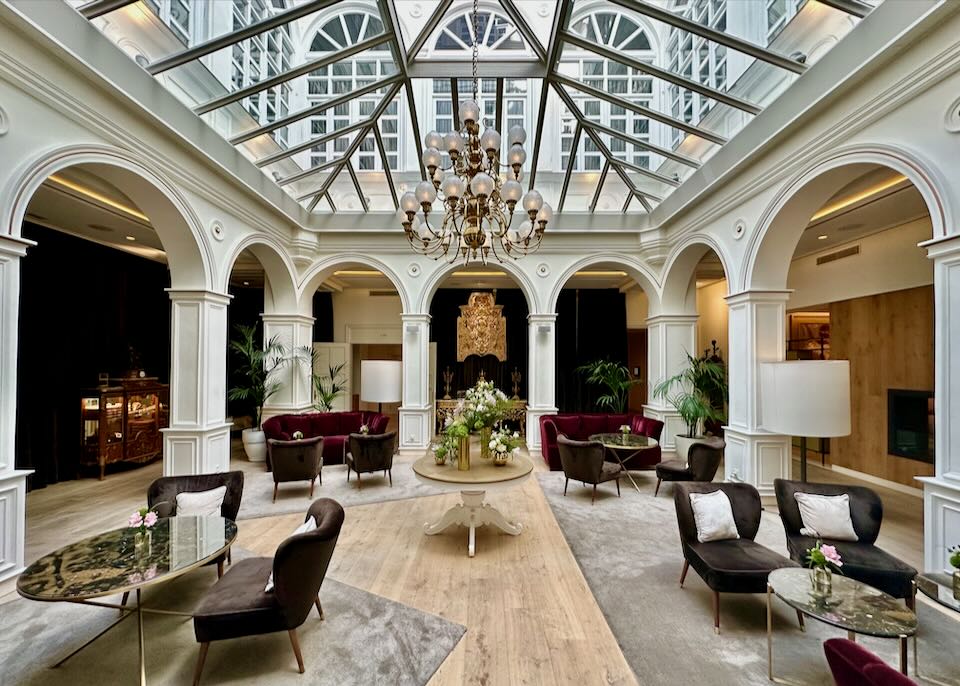
The elegant interior of Palacio de los Duques hotel in the Centro district.
- Best Hotels in Madrid Centro
Palacio de los Duques • Hotel phone: +34 915 41 67 00
Four Seasons • Hotel phone: +34 910 88 33 33
CoolRooms Palacio de Atocha • Hotel phone: +34 910 88 77 80
Hyatt Centric Gran Via • Hotel phone: +34 918 37 12 34
VP Plaza España Design • Hotel phone: +34 915 95 55 10- Best Cheap/Midrange Hotels
B&B Hotel Puerta del Sol • Hotel phone: +34 914 89 05 91
Central Palace Madrid • Hotel phone: +34 915 48 20 18
Hostal Adriano • Hotel phone: +34 915 21 13 39
Hostal Madrid • Hotel phone: +34 915 22 00 60
Hostal Patria • Hotel phone: +34 913 66 21 87- Best Hostels
Cats Hostel Sol • Hotel phone: +34 913 69 28 07
The Hat • Hotel phone: +34 917 72 85 72
Onefam Sungate • Hotel phone: +34 910 23 68 06
Toc Hostel • Hotel phone: +34 915 32 13 042. Huertas

Sitting between Centro (specifically, Puerta del Sol) and Retiro, Huertas is the place to go to kick off your night. Calle Huertas, in particular, is lined with bars that range from hip to dive, while Calle Leon is good for independent shops, old-school delis, and drinking holes of every stripe. Plaza Santa Ana is ringed with bars and cafes with outdoor seating, perfect for whiling away afternoons and evenings (Cervecería Alemana is an old haunt of Ernest Hemingway). Calle Huertas leads you directly to the Paseo del Prado and its museums, while the few streets just north of Calle Huertas (known as Barrio de Las Letras) are Madrid’s former literary quarter – writers such as Cervantes and Lope de Vega once lived there. This part of Huertas is less raucous and more arty, with several former writers’ residences turned into museums. Cervantes is buried in the Convento de las Trinitarias, while the Casa de Lope de Vega is small but enlightening museum dedicated to the 17th-century playwright (guided tours only).
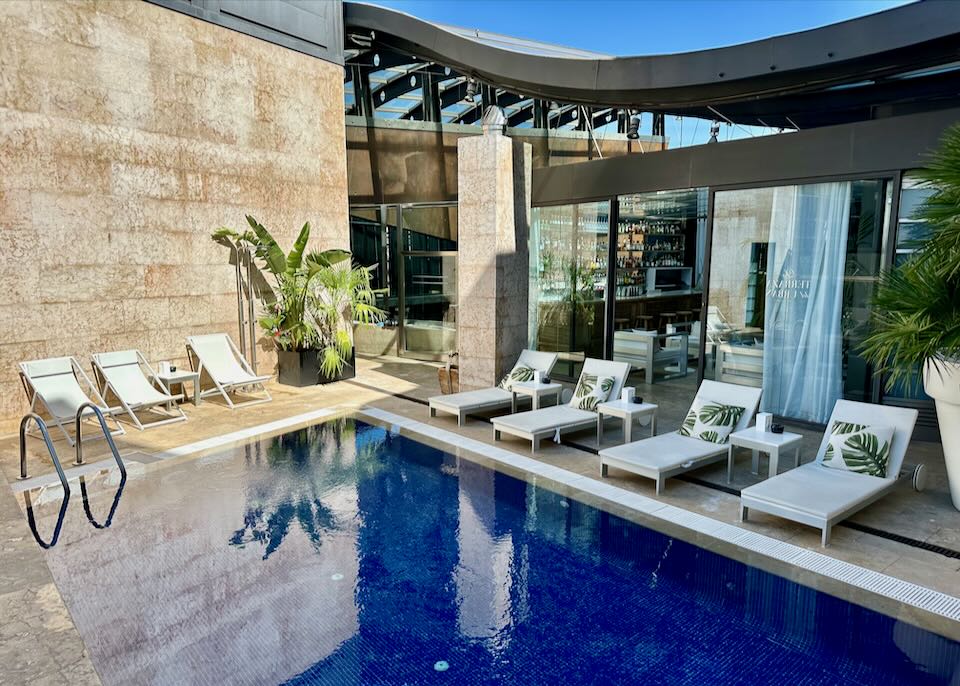
We love the small but refreshing rooftop pool at the Hotel Urban, just down the street from the Thyssen-Bornemisza National Museum and a 10-minute walk to the Prado.
- Best Hotels in Huertas
Gran Hotel Inglés • Hotel phone: +34 913 60 00 01
Atocha Hotel • Hotel phone: +34 911 08 06 60
Hotel Urban • Hotel phone: +34 917 87 77 70
Westin Palace • Hotel phone: +34 913 60 80 00- Best Cheap/Midrange Hotels
Artistic B&B • Hotel phone: +34 673 46 79 26
Catalonia Atocha • Hotel phone: +34 914 20 37 70
Catalonia Las Cortes • Hotel phone: +34 913 89 60 51
Mercure Madrid Centro • Hotel phone: +34 913 60 00 11
Room Mate Alba • Hotel phone: +34 910 80 64 71
Room Mate Alicia • Hotel phone: +34 913 89 60 95- Best Hostel
Room00 Ventura • Hotel phone: +34 914 20 44 813. Malasaña
This hip, grungy neighborhood lives for the night. In the late 1970s and throughout the 1980s, Malasaña was known for its experimental La Movida Madrileña movement of rock music, sexual freedom, and illegal substance use. The tiny streets are still marked with remnants of graffiti and dotted with tattoo parlors, but vintage shops, hip bars, trendy cafés, and restaurants have replaced much of the earlier seediness and grime. Where Malasaña is short on sights (with the exception of several small art galleries, the beautiful church of San Antonio de los Alemanes, and the main square, Plaza de Dos de Mayo, which commemorates the rebellion against Napoleon’s occupation of the city), it’s huge on nightlife. There are numerous bars and restaurants along Calle Espiritu Santo, Libertad, and Malasaña’s mostly pedestrianized thoroughfare, Fuencarral. The neighborhood is a 10-minute walk north of Centro.
Malasaña is the place to look for cheap hotels and cheaper rates in general – prices are usually lower than in Centro, even at the top level.
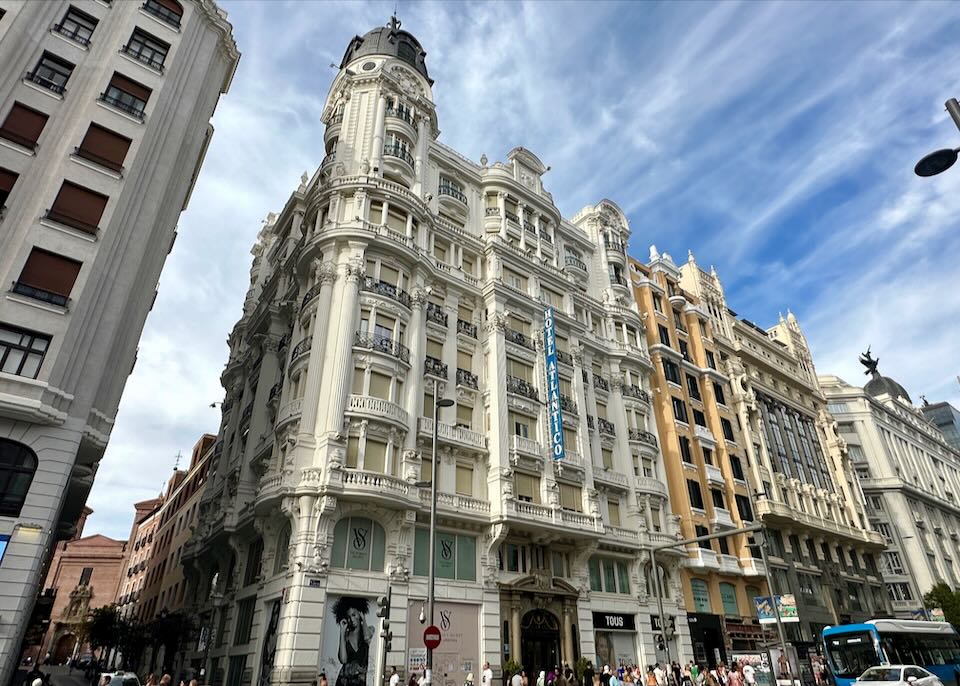
Hotel Atlántico has a perfect central location right on Gran Via and next to the Callao Metro Station.
- Best Hotel in Malasaña
Hotel Atlántico • Hotel phone: +34 915 22 64 80- Best Cheap/Midrange Hotels
Riu Plaza España • Hotel phone: +34 919 19 33 93
Hostal Adis • Hotel phone: +34 910 00 64 73
Ibis Styles Madrid Centro Maravillas • Hotel phone: +34 914 48 58 16
Pension Salomé • Hotel phone: +34 915 21 18 47
SmartRental Centric II • Hotel phone: +34 915 02 77 83- Best Hostel
Pil Pil Hostel • Hotel phone: +34 910 51 96 734. Chueca
A short walk both from Malasaña and Centro’s Gran Vía, Chueca in the northeast sector of the city center is lively around the clock. Many of the city’s main attractions are within easy walking distance, but in Chueca itself you’ll find the art-filled Museum of Romanticism, housed in the former 18th-century palace of the Marquis of Matallana, the excellent History Museum of Madrid, and the whimsical Longoria Palace, one of the city’s few Art Nouveau buildings.
Palacio Longoria
By day, Chueca is also one of the best places in Madrid to dine out, with numerous hip restaurants and cafes lining its narrow streets. You’ll find the three-story gourmet food market, Mercado San Antón, along Calle Agusto Figueroa. Fashion shopping is excellent, too: the same street is known for its numerous shoe boutiques. By night, Chueca comes alive with bars that stay open until dawn. Madrid’s main LGBTQ neighborhood, Chueca is where you’ll find most of the city’s gay-friendly clubs and bars. And no night crawl is complete without a visit to the local institutions of Museo Chicote (where Hemingway and Sinatra used to drink), and Taberna de Ángel Sierra on Plaza de Chueca, an old-school vermouth bar.
Chueca is another great area to look for bargains, with a huge stock of cheap accommodation. Standards can be poor at the budget end – exceptions are listed below.
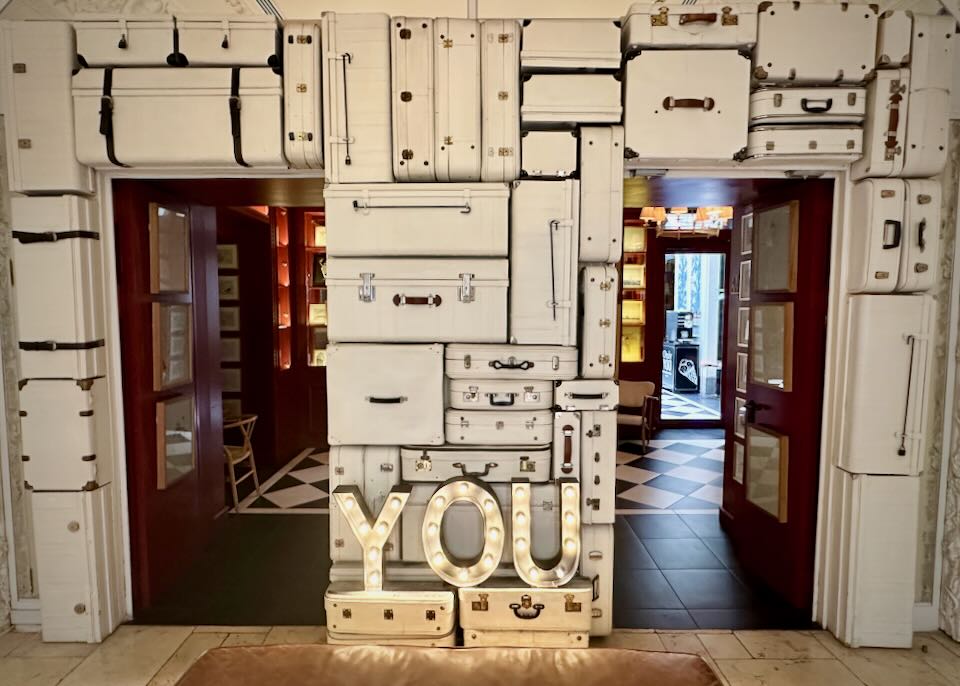
Quirky design details at Only YOU boutique hotel, set in a restored 19th-century Chueca palace.
- Best Hotels in Chueca
Only YOU • Hotel phone: +34 910 05 22 22
URSO Hotel & Spa • Hotel phone: +34 914 44 44 58- Best Cheap/Midrange Hotels
Casa Chueca • Hotel phone: +34 915 23 81 27
B&B Hotel Fuencarral 52 • Hotel phone: +34 912 78 79 62
Room Mate Oscar • Hotel phone: +34 917 01 11 73- Best Hostels
Bastardo Hostel • Hotel phone: +34 682 51 95 35
Room00 Chueca • Hotel phone: +34 913 68 81 115. Retiro
Bordered by the Paseo del Prado to the west and Av deLa Paz to the east, the neighborhood of Retiro encompasses the vast Parque de Buen Retiro and the affluent residential streets immediately east of the city center. The park itself is a joy to explore, home to the wonderfully picturesque Palacio de Cristal and the ornately tiled Palacio de Velázquez (both housing contemporary art exhibits from the Museo Reina Sofia, and a large boating lake.
The Prado Museum
Apart from the park, Retiro is also famous as a home to the ‘Golden Triangle’ – the city’s three most important art museums. World-class Museo del Prado (home to the likes of Las Meninas by Velázquez and The Garden of Earthly Delights by Hieronymus Bosch) is directly on the Paseo del Prado, while the private collection of Museo Thyssen-Bornemisza is across the street in the old Villahermosa Palace. The Centro de Arte Reina Sofia, at the south end of Paseo del Prado (with Jean Nouvel’s elegant modern extension), is Madrid’s biggest and best repository of contemporary art, housing work by Dalí, Miró and Juan Gris, but most famously Picasso’s Guernica. Don’t miss the stalls opposite the museum in the Cuesta de Moyano Book Market, along pedestrianized Calle de Claudio Moyano on the southern end of the Real Jardín Botánico. Other attractions include the National Museum of Anthropology, Naval Museum, National Museum of Decorative Arts, and the eye-catching CaixaForum, a venue for art exhibitions with a vertical garden facade.
Estación de Atocha, Madrid’s main train station for southern and eastern Spain, lies at the southern end of Retiro, meaning easy transfers for those traveling by train.
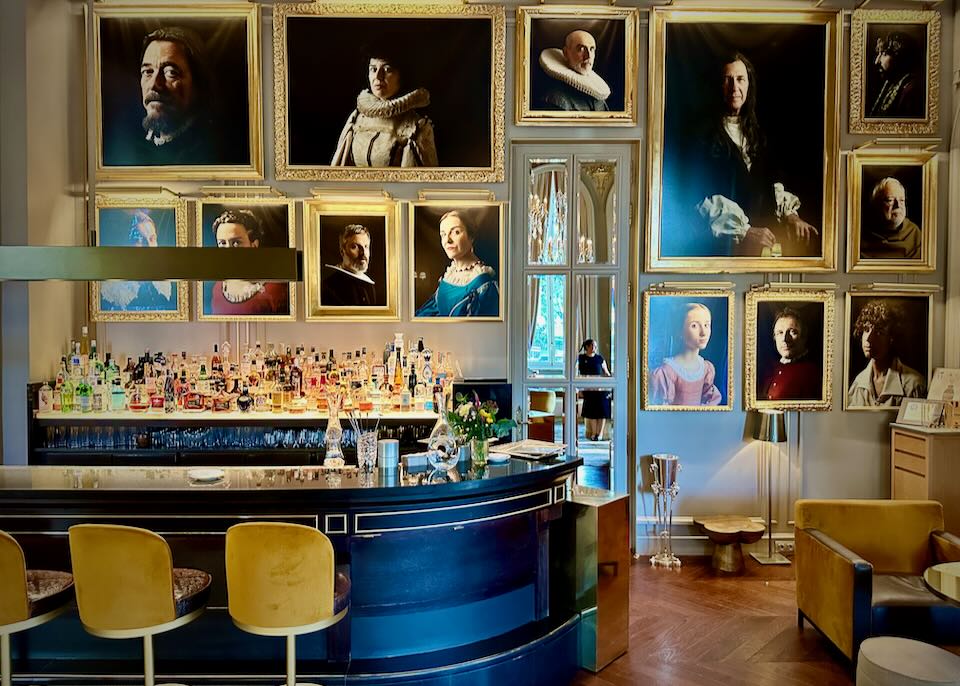
The atmospheric Pictura cocktail bar at the 5-star Mandarin Oriental Ritz in Madrid.
- Best Hotels in Retiro
Mandarin Oriental Ritz • Hotel phone: +34 917 01 67 67
Palacio del Retiro • Hotel phone: +34 915 23 74 60- Best Cheap/Midrange Hotels
8Rooms Madrid • Hotel phone: +34 915 51 31 26
NH Atocha • Hotel phone: +34 915 39 94 00
Petit Palace Lealtad Plaza • Hotel phone: +34 915 22 45 47
SLEEP’N Atocha • Hotel phone: +34 915 39 98 07- Best Hostel
Oxygen Hostel • Hotel phone: +34 687 17 15 176. Salamanca
Just north of Retiro, this grid of wide, leafy streets and avenues is Madrid’s most upscale residential neighborhood. The two main avenues here are Calle de Serrano and Calle de Velázquez. If shopping is your passion, don’t miss the boutiques along the Milla de Oro (Golden Mile) on and around Calle de Serrano and Calle de Claudio Coello. Ones to look out for include Sita Murt (chic knitwear), Nac Madrid (high-end footwear), and Isoleé (luxury mini-department store). Other attractions include the National Archaeological Museum (which displays the “Lady of Elche”, a rare Celtiberian bust from the 4th century BC), and Madrid’s iconic bull ring – Plaza de Toros Monumental de Las Ventas. To the north there’s wonderful (and less crowded) art collections in the Museo Sorolla and Museo Lázaro Galdiano, with the family-friendly National Museum of Natural Sciences holding a compelling collection of dinosaur bones, fossils, and giant whale skeletons. Salamanca is quite spread out, so riding the metro is a good way to get around here. This barrio is liveliest during the day, though there are a few excellent bars and restaurants near the Retiro for evenings out.
Salamanca is home to some of the best luxury hotels in the city and is an expensive place to stay in general.
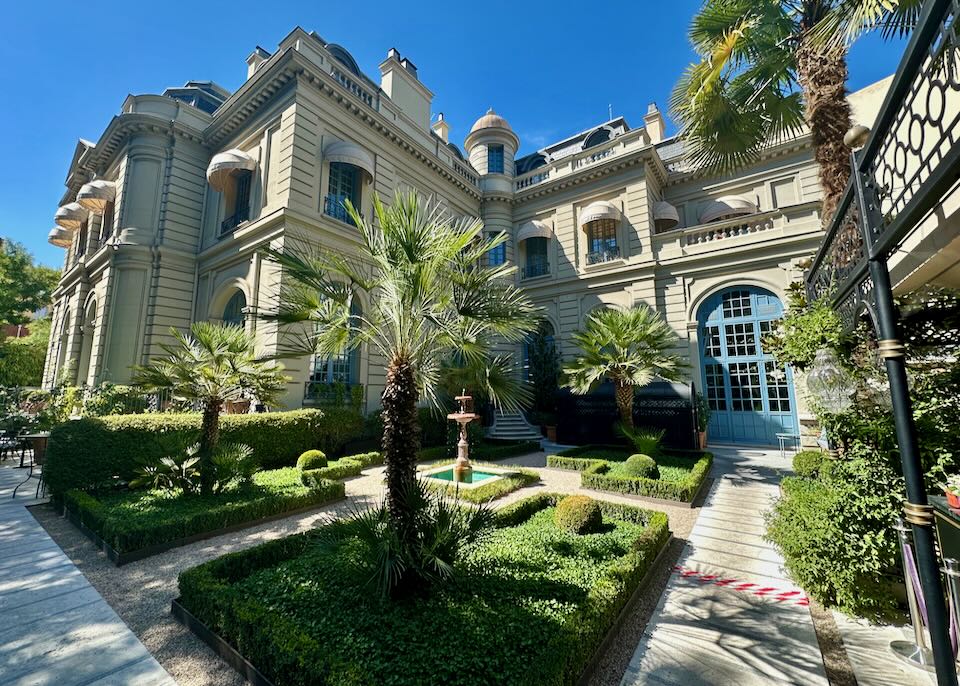
The beautiful and luxurious Santo Mauro hotel in Salamanca.
- Best Hotels in Salamanca
Barceló Emperatriz • Hotel phone: +34 913 42 24 90
Hospes Puerta de Alcalá • Hotel phone: +34 914 32 29 11
Fénix Gran Meliá • Hotel phone: +34 914 31 67 00
The Pavilions • Hotel phone: +34 913 10 75 00
Relais & Châteaux Orfila • Hotel phone: +34 917 02 77 70
Santo Mauro • Hotel phone: +34 913 19 69 00- Best Cheap/Midrange Hotels
NH Zurbano • Hotel phone: +34 914 41 45 00
The Match • Hotel phone: +34 633 62 17 76
Petit Palace President Castellana • Hotel phone: +34 915 77 19 517. La Latina
Just a few minutes’ walk south of Centro, La Latina’s main draws are its beautiful architecture – some of the city’s oldest – and vibrant nightlife. The neighborhood is known especially for its grand churches: the huge Basilica of San Francisco el Grande with its giant dome (bigger than St. Paul’s in London) and paintings by Zurbarán and Goya; the beautiful Church of Saint Andrew the Apostle; the church of Saint Isidore; and St Peter the Old, with its distinctive Moorish-style bell tower. Other highlights include the Museo de San Isidro, which charts the early history of Madrid, and Las Vistillas Garden, a popular spot to view sunset. The tiny streets of La Latina are a pleasure to explore on foot, and on Sundays the city’s largest flea market, El Rastro, takes up entire blocks, with crowds of pedestrians wandering from stall to stall to the accompaniment of street musicians. Most evenings, the tapas bars lining the streets are abuzz with life until late, with the biggest concentration located along Calle de la Cava Baja.
This part of town is less touristy than Centro, and there are not many hotels – we’ve listed a few good budget options below.
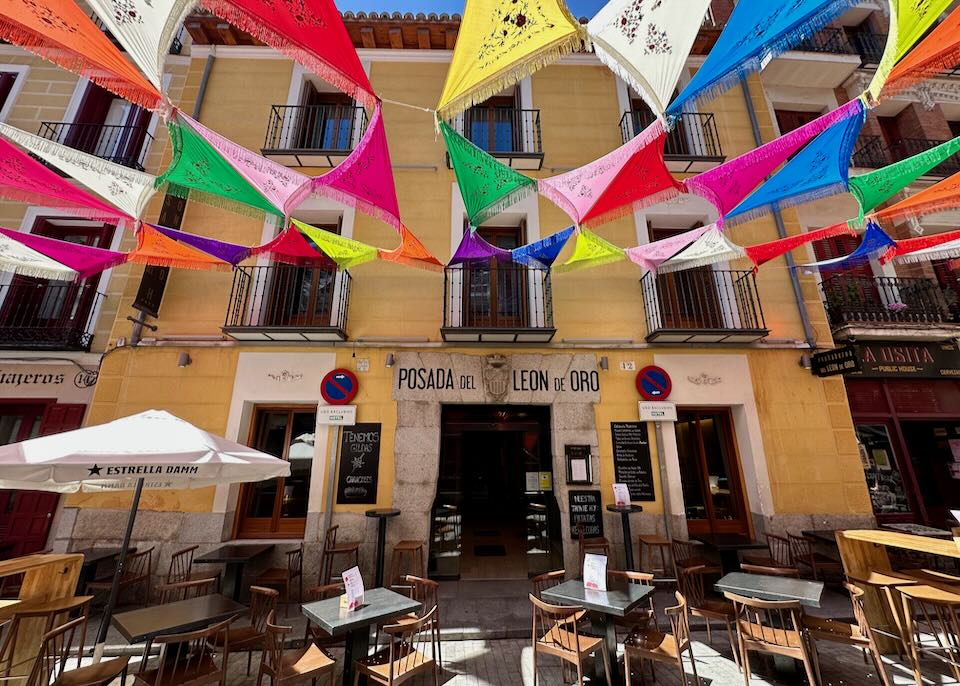
The boutique hotel Posada del León de Oro in La Latina is an excellent choice for travelers on a budget.
- Best Hotels in La Latina (Cheap/Midrange)
L&H La Latina • Hotel phone: +34 911 41 49 39
Posada del Dragón • Hotel phone: +34 911 19 14 24
Posada del León de Oro • Hotel phone: +34 911 19 14 94- Best Hostel
Petit Hostel • Hotel phone: +34 680 20 89 508. Lavapiés
Sandwiched between La Latina and Huertas, and just a few minutes’ walk from both Centro and the art museums of Retiro, Lavapiés is a buzzy, hip neighborhood on the south side of the city center that’s still a little rough around the edges. This ethnically diverse corner of the city is renowned for its diverse cuisine and trendy nightlife. Calle Lavapiés is locally known as “Curry Row” due to the proliferation of excellent Indian restaurants, and Calle Argumosa is particularly good for hipster bars and al fresco drinking. On Sundays, the El Rastro flea market spills over into Lavapiés from La Latina.
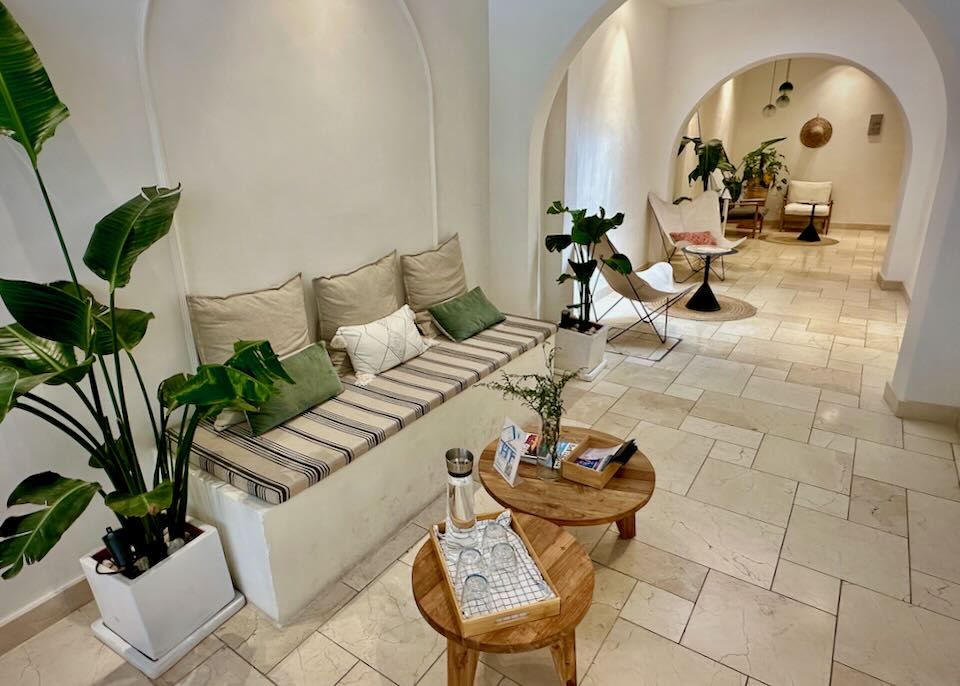
The chic and comfortable Casa du Soleil is a great value boutique hotel in Lavapiés
- Best Hotel in Lavapiés
Hotel Artrip • Hotel phone: +34 915 39 32 82- Best Cheap/Midrange Hotels
Casa du Soleil • Hotel phone: +34 673 84 50 00- Best Hostels
Ok Hostel • Hotel phone: +34 914 29 37 44
2060 The Newton Hostel • Hotel phone: +34 919 54 17 44
Central House Lavapiés • Hotel phone: +34 913 53 56 019. Argüelles & Moncloa (aka “Princesa”)
Just north of the royal palace and Plaza de España in central Madrid, leafy Argüelles consists of large parks and residential streets. The largest park, Parque del Oeste, is where you’ll find the Templo de Debod – a reconstructed 4th-century BC Egyptian temple and a favorite spot for sunset-watching. Down by the narrow River Mazanares, the Ermita de San Antonio de la Florida is the resting place of Goya and is decorated with some of his most beautiful frescoes – nearby Casa Mingo is famed for its roast chicken, cider and Spanish classics. The Teleférico de Madrid cable car runs west across the river from near here to the expansive Parque Casa de Campo, home to Madrid’s Zoo Aquarium, theme parks, historic monuments, and hiking trails.
Debod Temple at Parque del Oeste
North of Parque del Oeste, Argüelles and the Calle de la Princesa flow seamlessly into Moncloa, home to Madrid’s main university, the monumental Arco de Moncloa (built by Franco in 1956 to his commemorate his victory in the Spanish Civil War), and the Faro de Moncloa – a lighthouse-like observation tower with excellent views of the surrounding city. The Museum of the Americas holds fascinating collections of pre-Columbian American art, while the Museo del Traje traces the history of fashion. Further north is the Moncloa Palace, official residence of Spain’s prime minister since 1977. This part of town has a large student population, and a few lively bars, with the nightlife of Malasaña and Chueca a short walk east. The main street, Calle de la Princesa, is lined with high street boutiques and department stores. Madrid’s main attractions are a longish walk or short metro ride away; Moncloa, Argüelles and Plaza de España are the area’s main metro stops.
There are not many hotels beyond the busy Plaza España; it’s far less touristy up here, being dominated by the huge campuses of Universidad Complutense de Madrid and Universidad Politécnica de Madrid.
- Best Hotels in Argüelles & Moncloa
Meliá Princesa • Hotel phone: +34 915 41 82 00
Barceló Torre de Madrid • Hotel phone: +34 915 24 23 99- Best Cheap/Midrange Hotels
Social Hub Madrid • Hotel phone: +34 919 01 12 26
Suites Viena Plaza de España • Hotel phone: +34 917 58 36 05More Madrid Neighborhoods
We’ve covered our favorite neighborhoods to visit and stay in more detail above, but soccer fans should also make a pilgrimage to the the wealthy Chamartín neighborhood north of the city center to see Santiago Bernabéu Stadium, home of one of Europe’s most famous teams, Real Madrid (easily reached by metro). You can tour the stadium and visit the on-site museum, match tickets are available online. The best hotels nearby include Canopy Castellana, H10 Tribeca, and AC Hotel Aitana. Fierce rivals Atlético Madrid play at the Metropolitano Stadium in the Rosas neighborhood, northeast of the city center (also with its own metro stop and small museum) – few games match the intensity of the “Derbi Madrileño” when the two teams meet.
There’s not much point in staying near Madrid-Barajas Airport unless you have avery early flight (getting to the airport on public transport can take a while depending on where you stay). If you do need to stay here, HelloSky Air Rooms is the most convenient (if somewhat mediocre) option for Terminal 4, located inside the terminal. For terminals 1, 2, and 3, the hotels are all outside the airport and fairly basic: the Sercotel, Meliá, and ibis are solid chain options.
Madrid Travel Tips
- Madrid–Barajas Airport is about 8 miles (13 km) northeast of the city center. As the largest airport in Spain, it’s well connected to cities all over the world, including 9 in North America. Metro Line 8 links terminal 1-4 with Nuevos Ministerios station, where you’ll have to change for the city center. Fast regional trains also link Terminal 4 with the city center; a free shuttle bus connects Terminal 4 with Terminals 1–3. Taxis charge a flat €30 into the city, which is not bad if you have a lot of luggage or just want to save time.
- Uber is available in Madrid, but as there are relatively few drivers, it’s usually easier and cheaper to hail/order a local taxi. Uber has faced numerous challenges operating in Spain, not least extremely hostile resistance from local taxi unions.
- Almost everyone you are likely to deal with in cosmopolitan Madrid will be able to speak (or at least understand some) English, except for a few taxi drivers and owners of small cafés/shops. Try to learn some Spanish anyway, before you go.
- As with many European cities, there are several tourist passes offered for Madrid – as always, these are good value only if you intend to do a lot of sightseeing in a short amount of time. When choosing between the Madrid Digital Card or one of the various museum passes on offer, coming up with an itinerary and comparing savings pass-by-pass is tedious but effective.
- Bike rental is available through bikeshare schemes like BiciMAD, which offers e-bikes with 1, 3 or 5-day passes, and several traditional bike rental shops like Don Cicleto. However, Madrid is not a good place for tourists to ride bikes – there are plenty of slopes to negotiate and narrow streets in the old center shared with pedestrians and vehicles. Bike lanes are not common. The Anillo Verde bike trail encircles the city, but this is quite a way out.
- Free wi-fi is available at Madrid–Barajas Airport, and at cafés and museums throughout the city itself, as well as at the Plaza Mayor Tourist Information Centre, Plaza de Santo Domingo, shopping malls, and on city buses and regional trains.
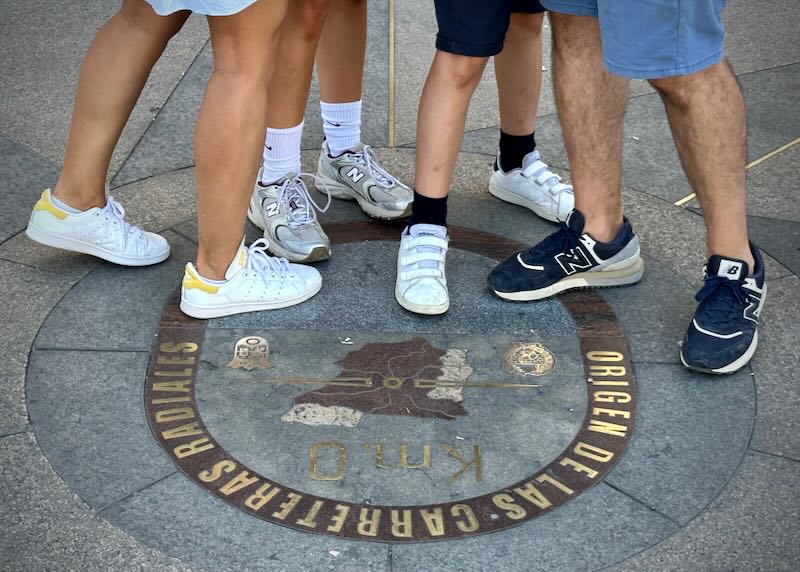
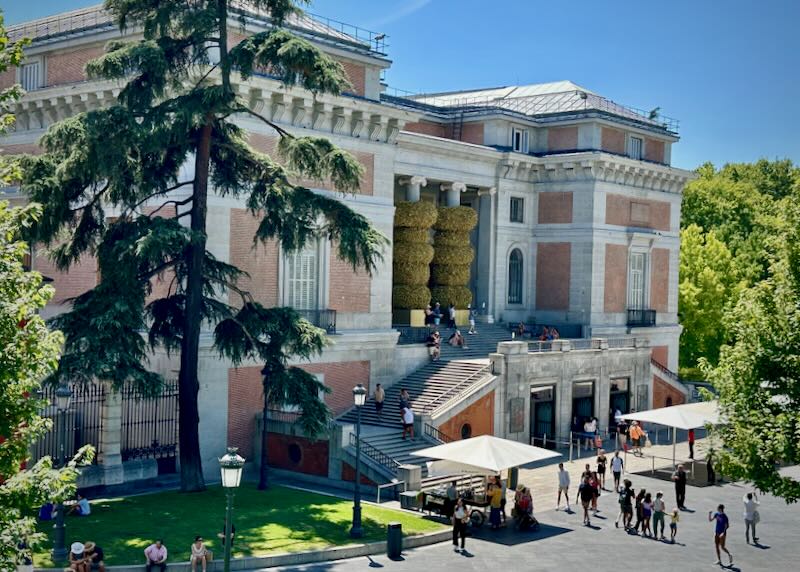

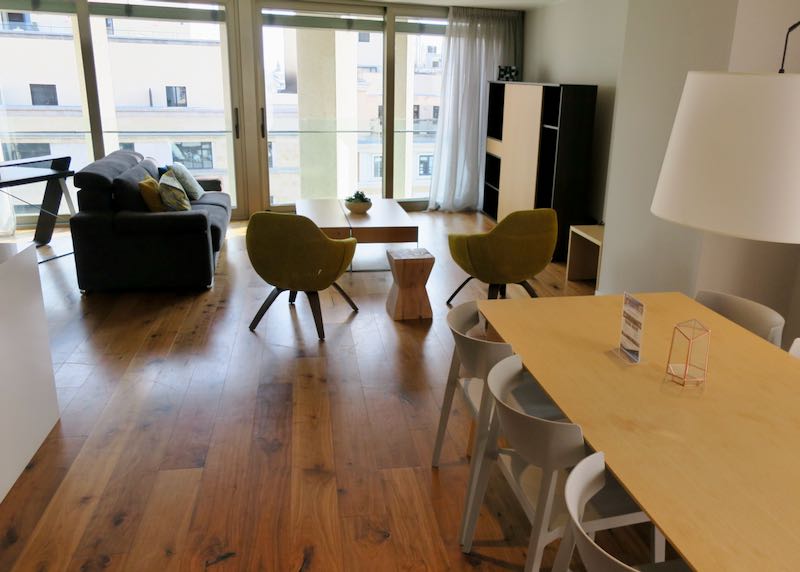
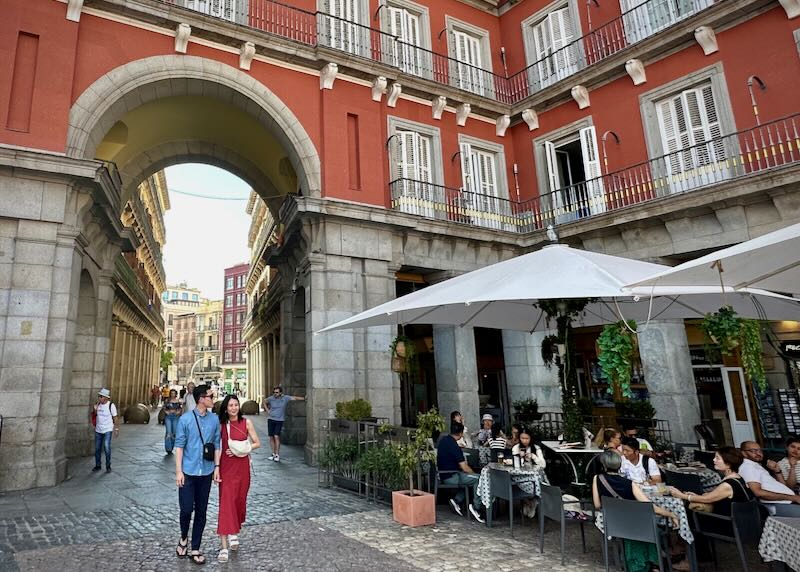
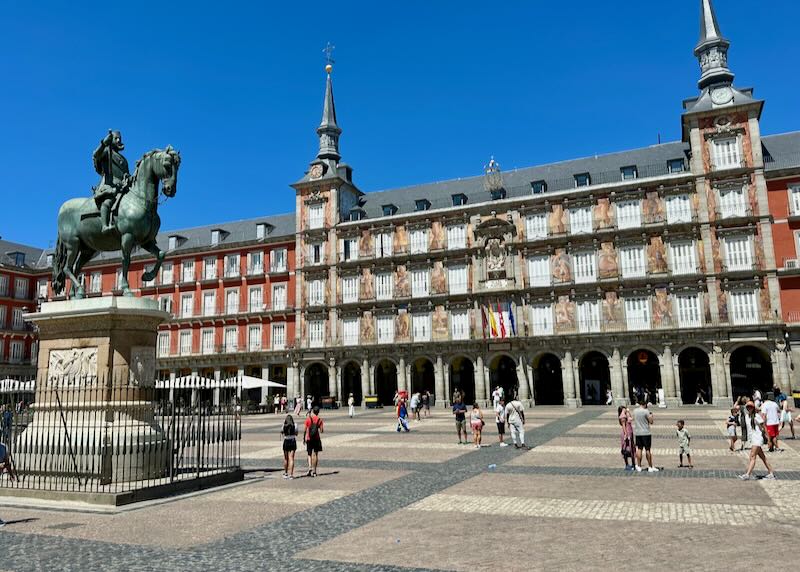

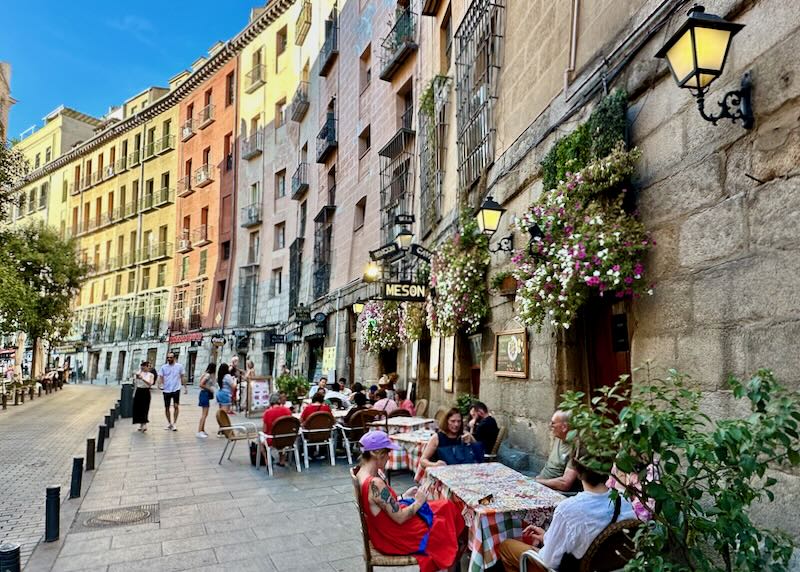
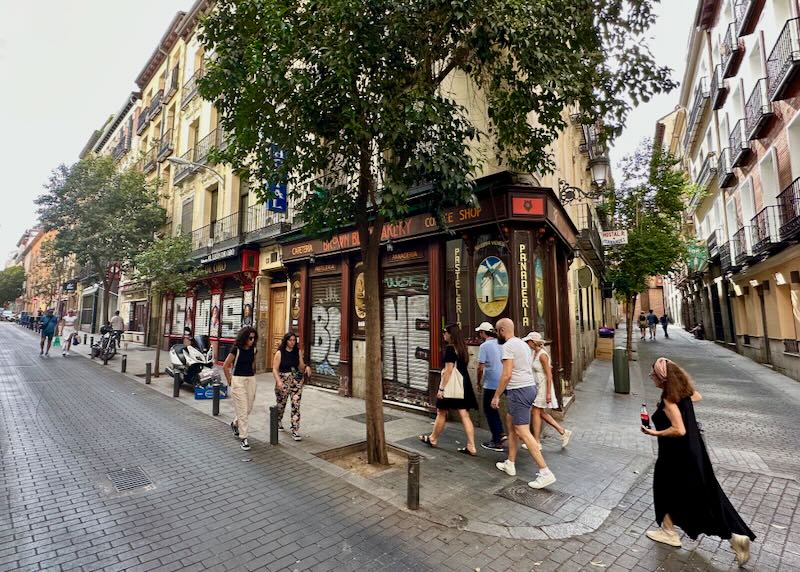
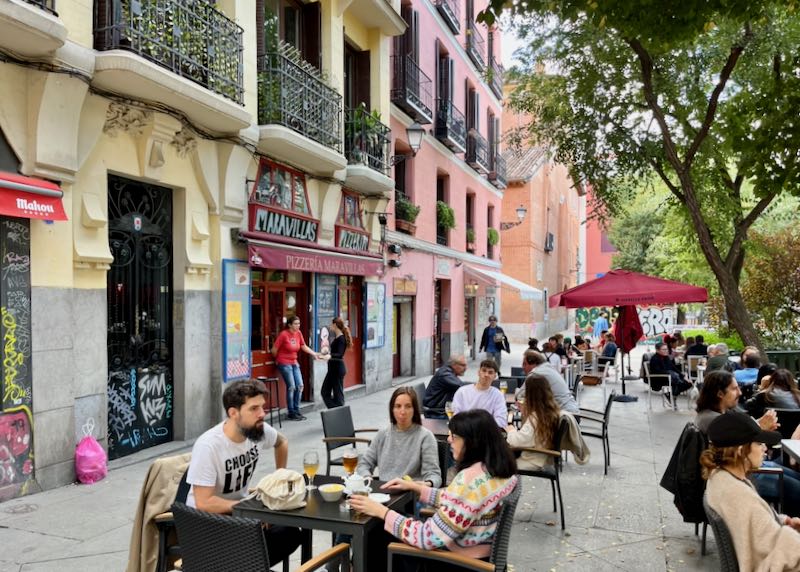

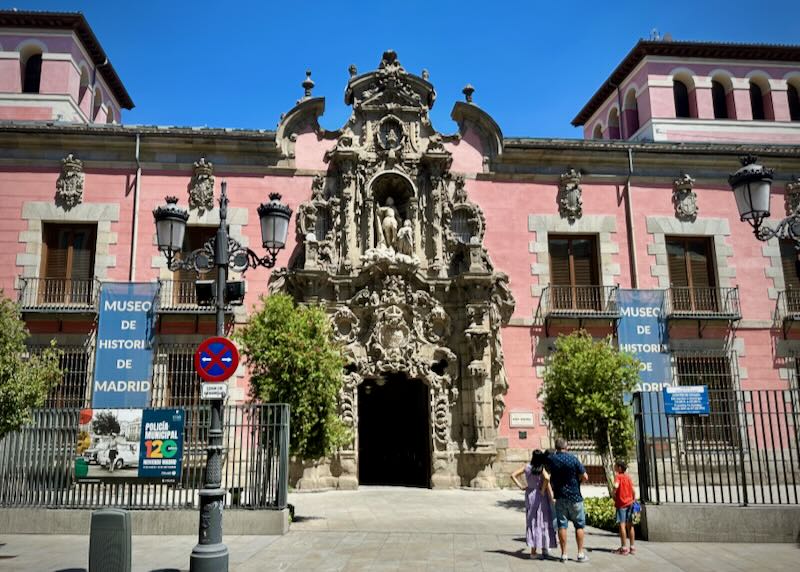

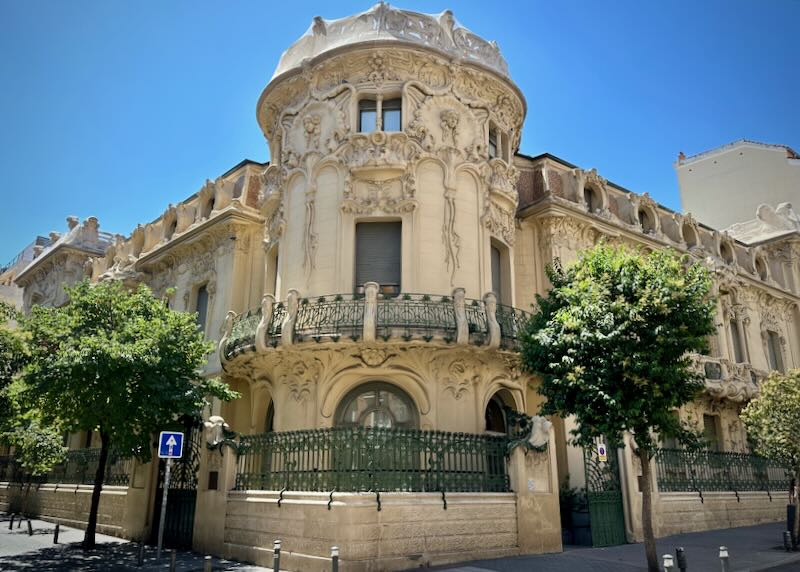
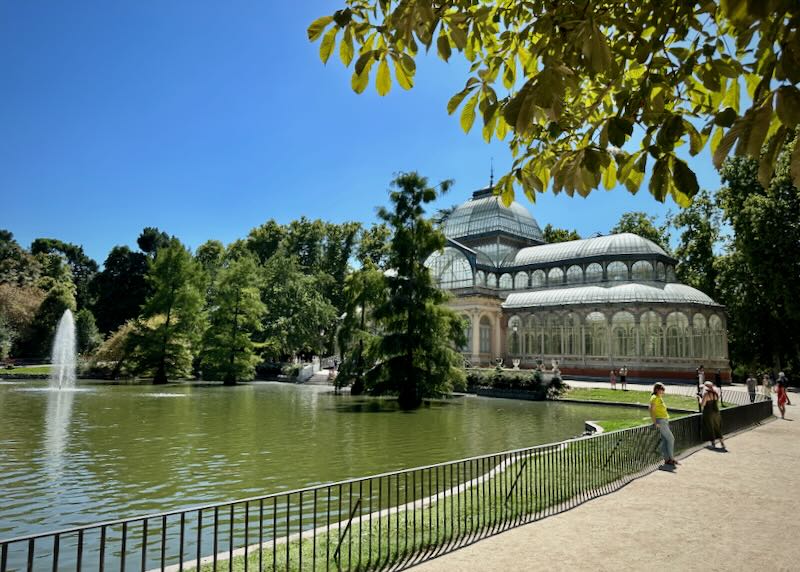

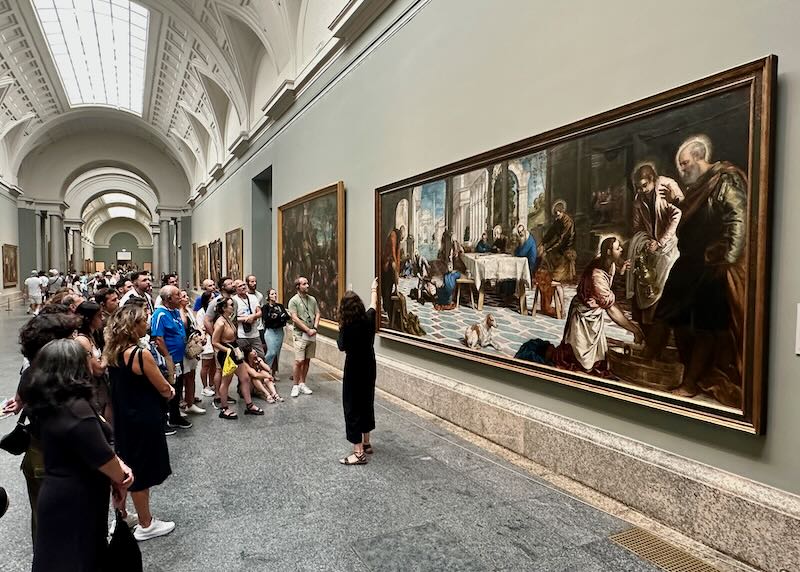
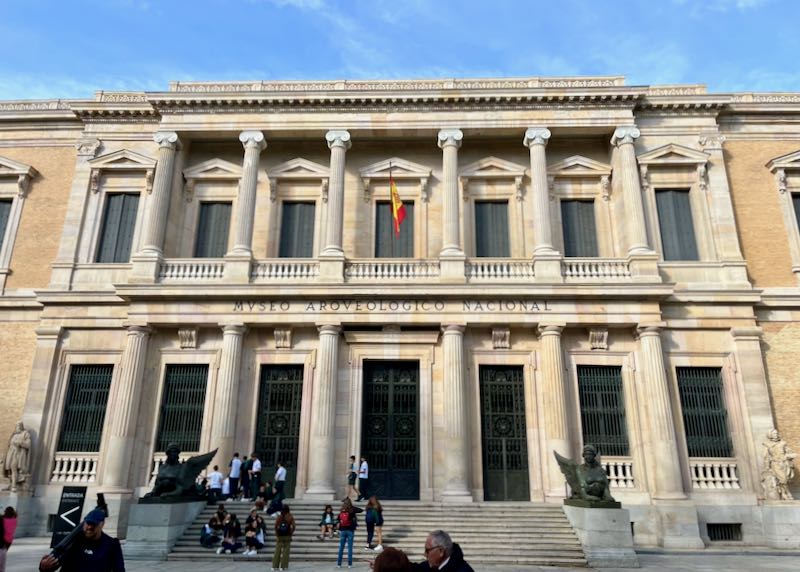

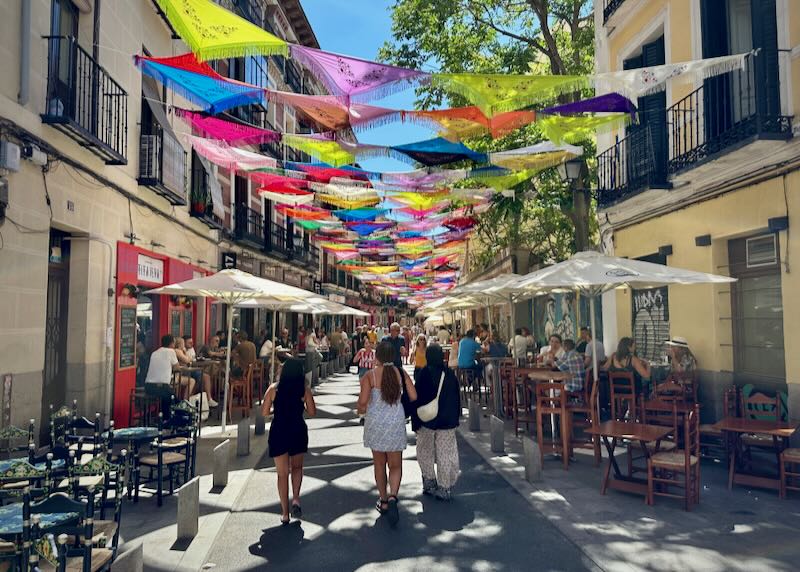

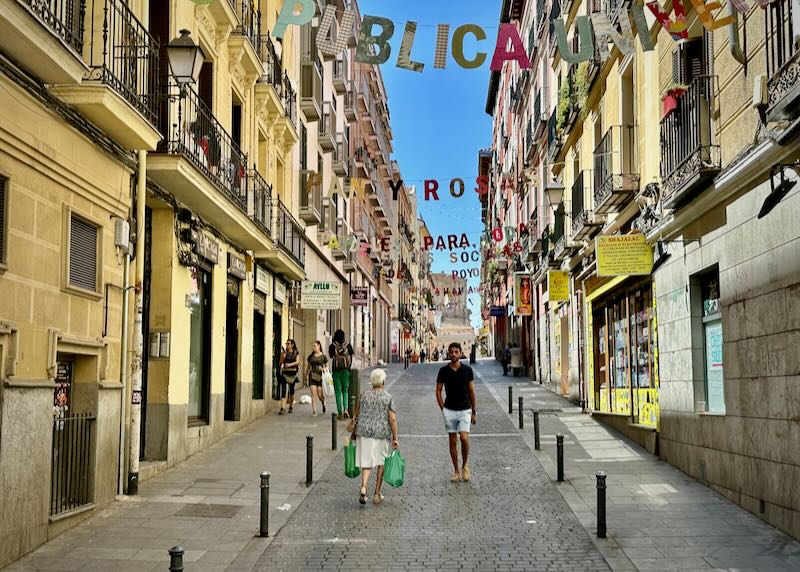

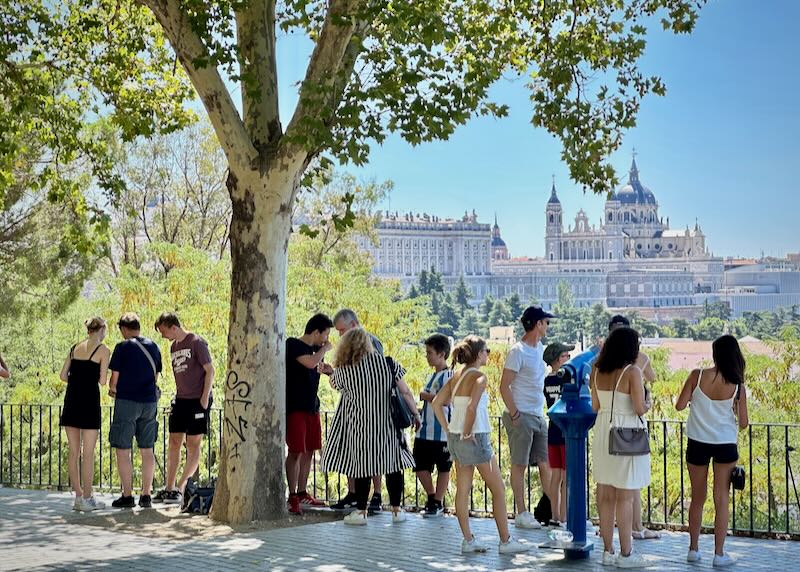

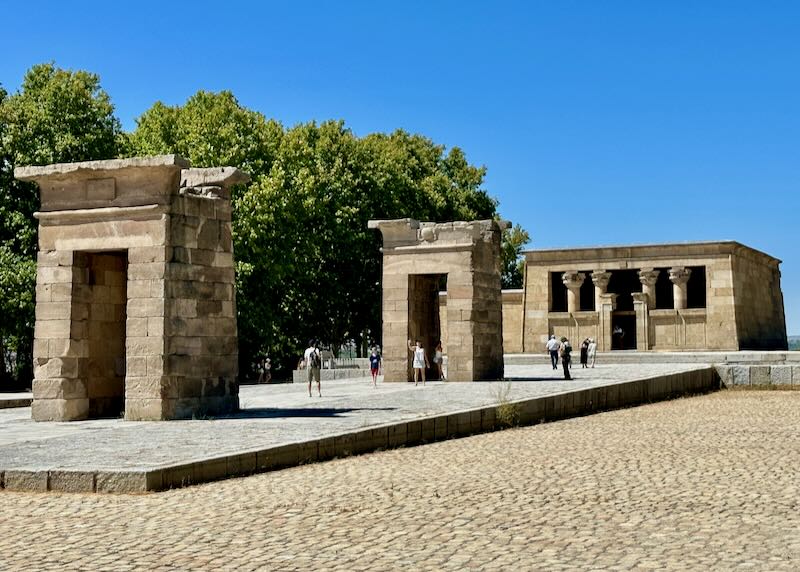
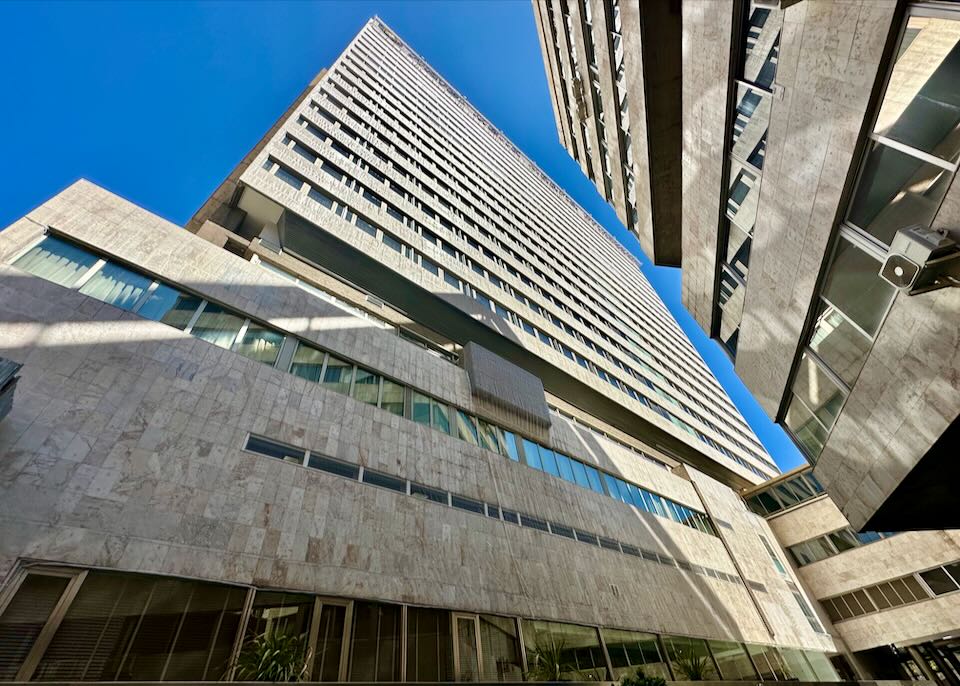
About Santorini Dave